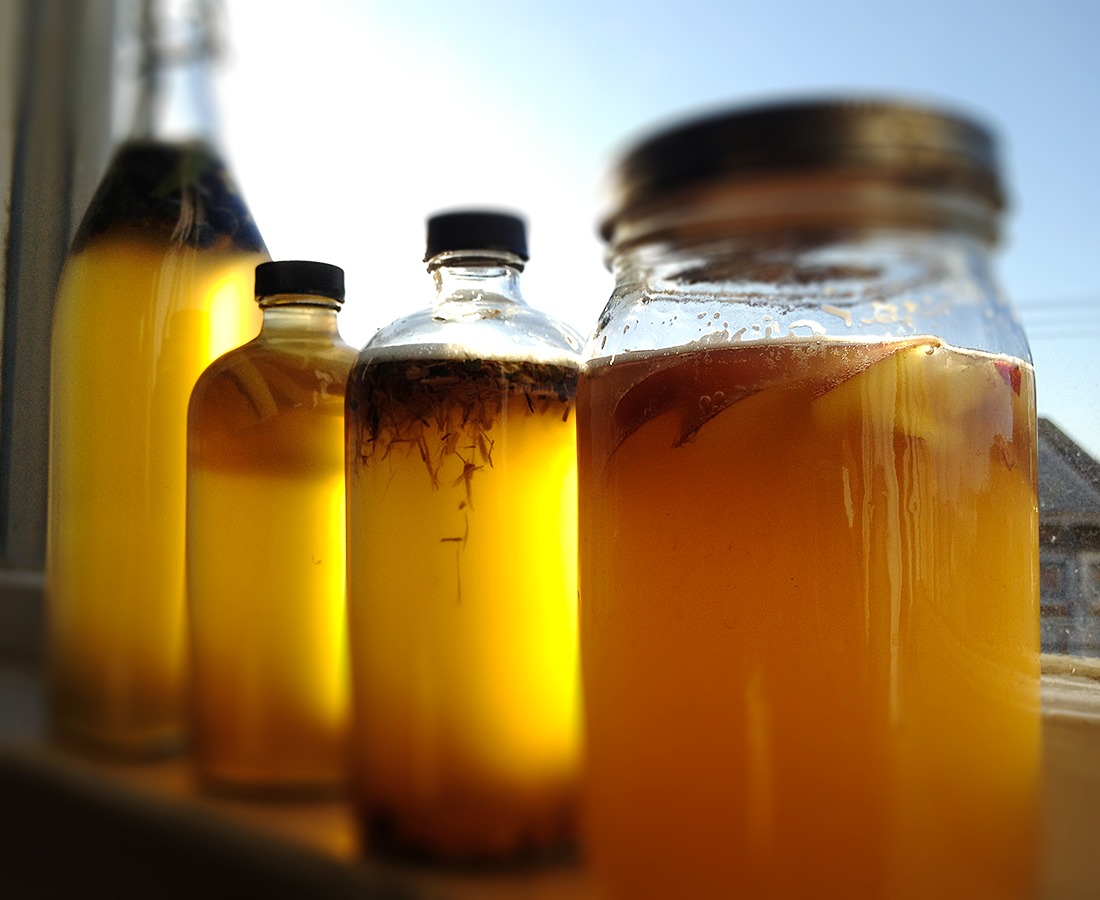
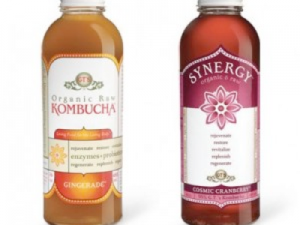 Many years ago I was walking through a health food store one day and I came across a bottle of what looked like juice on the shelf. I read the label and was surprised to see all of these health benefits it claimed including some whoppers such as cancer prevention. I was intrigued and found myself at the register buying a bottle. I opened it in the parking lot, took a taste, and almost spit it out! It was a flavor I was not expecting. I think I was expecting something sweet and sugary. However, as not to waste what I had just spent almost $4.00 on I continued drinking. To make a long story short I began trying all of the flavors they had one by one over a period of weeks. In time I decided which flavors were my favorite and continued to drink them over the years.
Many years ago I was walking through a health food store one day and I came across a bottle of what looked like juice on the shelf. I read the label and was surprised to see all of these health benefits it claimed including some whoppers such as cancer prevention. I was intrigued and found myself at the register buying a bottle. I opened it in the parking lot, took a taste, and almost spit it out! It was a flavor I was not expecting. I think I was expecting something sweet and sugary. However, as not to waste what I had just spent almost $4.00 on I continued drinking. To make a long story short I began trying all of the flavors they had one by one over a period of weeks. In time I decided which flavors were my favorite and continued to drink them over the years.
Since that time many more brands have popped up on the market, certain brands have been pulled off of shelves due to alcohol content only to be replaced by lighter or “enlightened” versions. During that short stint when there was no Kombucha on the shelves I came across a home brew kit and decided to make my own. Since then I have had many friends who currently drink the store bought Kombucha ask me “What do you mean you have to feed your Kombucha?” “What exactly is this stuff I’m drinking?”
So here it is. As short and sweet as I can make it. Anyone who has ever been curious on what the little “floaties” at the bottom of the bottle are…
What is Kombucha?
Kombucha AKA “The Mother.” Is a fermented tea brewed from a “SCOBY.” (Symbiotic Culture of Bacteria and Yeast) A SCOBY is a pancake shaped creature that looks like something right out of an Alien film.
Often called a mushroom, Kombucha is actually a colony of yeast and healthy bacteria. It is essentially a living organism.
Bacteria is living in you as well and there is more healthy bacteria than human cells in your body. YAY bacteria!
What are the health benefits?
There are so many implied health benefits to drinking Kombucha tea that this article would be too long. Here are the claims that are the most scientifically researched:
- Kombucha tea is rich in antioxidants. Antioxidants will help strengthen the immune system by suppressing the harmful activities of free radicals. With a stronger immune system, one becomes less susceptible to illnesses and infections.
- Kombucha is also rich in Glucaric acid which has been reported to help with certain cancers.
- Aside from Glucaric acid, Kombucha tea is also fortified with glucosamines. These are substances needed by the joints to stay strong and healthy. In particular, glucosamines help promote the production of hyaluronic acid which helps reduce arthritis-related pain and preserves the form and structure of cartilages. Hyaluronic acid also allows for the body’s connective tissues to bind more moisture, thereby maintaining healthy tissues, flexibility, and lubrication in the joints.
- Kombucha helps balance PH in the body. Imbalanced PH is responsible for hundreds of degenerative diseases.
Can Kombucha be unhealthy?
First thing I want to say about this is you definitely can have too much of a good thing. We hear something is good for you and we decide to gorge ourselves with it. Drink in moderation. With that said, there is a lot of material out there mostly from unreliable sources that suggest there are health risks to drinking Kombucha.
Ultimately the only research I could find that was valid were health concerns from batches of Kombucha that had been contaminated by unclean methods of preparation. That would happen to ANYTHING prepared and stored incorrectly. This is the same reason why almost everything you buy in the store in liquid form including milk and juice has been pasteurized (boiled). The problem with this is it not only kills possible pathogens in the food, it also kills the nutrition and digestive enzymes we need as well. We will continue this in another discussion down the road.
How is Kombucha prepared?
I thought you would never ask! Below is a description of how I prepared my most recent batch of Kombucha. I will also answer questions you may have had about types of sugar and what is needed to prepare it.
Lets, get started!
- You need a SCOBY. I recommend getting one from a source on the internet or at a health food store to start just so you know you are getting one from a good source. With that said, if you are one of my students or friends and interested- each time I make a new batch I end up with a new baby and I am happy to give them away. Here is a pic of a full grown SCOBY in a container.
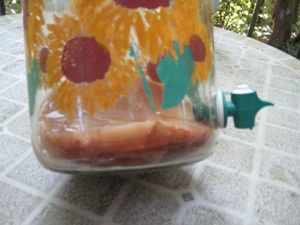
- You need a container to put it in. I prefer sun tea jars with a spigot where you can easily get the liquid out. There can be absolutely NO METAL in the container. Metal will hurt your SCOBY.
- You need some tea. Organic Black or Green tea is best in my opinion. There is controversy on using herbal teas. The main reasons I have found is there are components in the black and green tea that have anti-fungal properties and reduce the risk of mold growing in your kombucha. I have never had this happen but I’ve heard it can be a problem. However with that said I sometimes use flavored herbal teas mixed in with my green tea. If you use bagged tea use about 12-15 bags per gallon of water.
- You will need sugar. I am all about not eating sugar. Refined sugar especially is poison for our bodies. With that said, the sugar is not for you, it’s for the SCOBY. It eats the sugar and converts it into healthy acids that we then consume for health benefits. I prefer organic unrefined raw sugar out of the bulk at the health food store. You can use molasses and even agave (though i’m not a fan). The main controversy is honey. Some will say honey is ok, however the problem with using honey for kombucha is honey has anti-bacterial properties and the kombucha logically can not live in that environment for very long. Start with sugar, experiment when you perfect your recipe. You will need one cup per gallon of tea.
- Boil the gallon of water in a large, NON METAL, bowl. Add the tea bags. Let stand for 5 minutes. Take out the bags and add the sugar. Stir in till it dissolves.

- Once the sugar dissolves let the tea cool for a couple hours to room temperature.
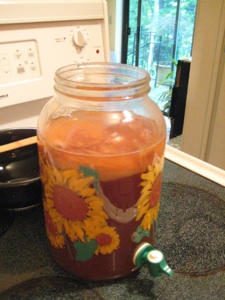
- Add the SCOBY to the tea in your storage container. Tie a cloth over the top so it can breath but is covered. Store in a dark warm environment. They do not like direct light for very long. Especially sunlight.

- Let it ferment. I usually let mine ferment for about 4 weeks. A friend of mine says his is often perfect in ten days. I have waited almost 8 weeks. It seems the longer it ferments the stronger the Kombucha is. Once it’s done you can bottle it. I use a non-metallic funnel and resealable bottles.
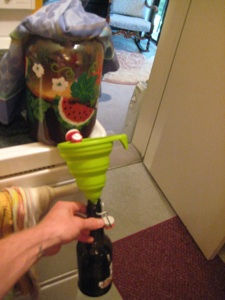
- Refrigerate the elixir until you are ready to drink it. Some people will add some berries or ginger to the bottle after it’s been bottled to add flavor and effervescence. I have not tried this approach yet personally.
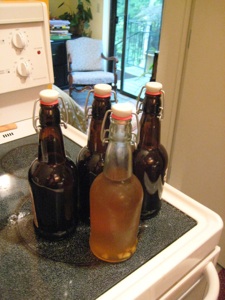
Making your own Kombucha is inexpensive and a fun way to reconnect with a process of fermentation. As we take the mystery out of where our food comes from it empowers us to be more in control of what we put into our bodies. Whether you take on making your own kombucha, culturing your own yogurt, grinding your own grains into flours, or growing your own garden full of vitamin rich vegetables you will be getting closer to knowing your food and where it comes from which will ultimately bring you closer to the health you deserve.
